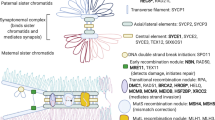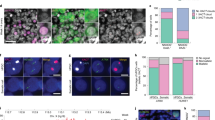Abstract
Multiple ovulations are uncommon in humans, cattle and many breeds of sheep. Pituitary gonadotrophins and as yet unidentified ovarian factors precisely regulate follicular development so that, normally, only one follicle is selected to ovulate. The Inverdale (FecXI) sheep, however, carries a naturally occurring X-linked mutation that causes increased ovulation rate and twin and triplet births in heterozygotes (FecXI/FecX+; ref. 1), but primary ovarian failure in homozygotes (FecXI/FecXI; ref. 2). Germ-cell development, formation of the follicle and the earliest stages of follicular growth are normal in FecXI/FecXI sheep, but follicular development beyond the primary stage is impaired3,4. A second family unrelated to the Inverdale sheep also has the same X-linked phenotype5 (Hanna, FecXH). Crossing FecXI with FecXH animals produces FecXI/FecXH infertile females phenotypically indistinguishable from FecXI/FecXI females6. We report here that the FecXI locus maps to an orthologous chromosomal region syntenic to human Xp11.2–11.4, which contains BMP15, encoding bone morphogenetic protein 15 (also known as growth differentiation factor 9B (GDF9B)). Whereas BMP15 is a member of the transforming growth factor β (TGFβ) superfamily and is specifically expressed in oocytes, its function is unknown7,8,9. We show that independent germline point mutations exist in FecXI and FecXH carriers. These findings establish that BMP15 is essential for female fertility and that natural mutations in an ovary-derived factor can cause both increased ovulation rate and infertility phenotypes in a dosage-sensitive manner.
This is a preview of subscription content, access via your institution
Access options
Subscribe to this journal
Receive 12 print issues and online access
$209.00 per year
only $17.42 per issue
Buy this article
- Purchase on Springer Link
- Instant access to full article PDF
Prices may be subject to local taxes which are calculated during checkout




Similar content being viewed by others

References
Davis, G.H., McEwan, J.C., Fennessy, P.F., Dodds, K.G. & Farquhar, P.A. Evidence for the presence of a major gene influencing ovulation rate on the X chromosome of sheep. Biol. Reprod. 44, 620–624 (1991).
Davis, G.H. et al. Infertility due to bilateral ovarian hypoplasia in sheep homozygous (FecXI FecXI) for the Inverdale prolificacy gene located on the X chromosome. Biol. Reprod. 46, 636–640 (1992).
Braw-Tal, R. et al. Ovaries of ewes homozygous for the X-linked Inverdale gene (FecXI) are devoid of secondary and tertiary follicles but contain many abnormal structures. Biol. Reprod. 49, 895–907 (1993).
Smith, P. et al. Ovarian morphology and endocrine characteristics of female sheep fetuses that are heterozygous or homozygous for the Inverdale prolificacy gene (FecXI). Biol. Reprod. 57, 1183–1192 (1997).
Davis, G.H., Bruce, G.D. & Reid, P.J. Breeding implications of the streak ovary condition in homozygous FecXI/FecXI Inverdale sheep. Proceedings of the 5th World Congress on Genetics Applied to Livestock Production 19, 249–252 (1994).
Davis, G.H., McEwan, J.C., Fennessy, P.F. & Dodds, K.G. Discovery of the Inverdale gene (FecX). Proceedings of the New Zealand Society of Animal Production 55, 289–290 (1995).
Laitinen, M. et al. A novel growth differentiation factor-9 (GDF-9) related factor is co- expressed with GDF-9 in mouse oocytes during folliculogenesis. Mech. Dev. 78, 135–140 (1998).
Dube, J.L. et al. The bone morphogenetic protein 15 gene is X-linked and expressed in oocytes. Mol. Endocrinol. 12, 1809–1817 (1998).
Aaltonen, J. et al. Human growth differentiation factor 9 (GDF-9) and its novel homolog GDF-9B are expressed in oocytes during early folliculogenesis. J. Clin. Endocrinol. Metab. 84, 2744–2750 (1999).
Galloway, S.M. et al. A linkage map of the ovine X chromosome. Genome Res. 6, 667–677 (1996).
Jaatinen, R. et al. Localization of growth differentiation factor-9 (GDF-9) mRNA and protein in rat ovaries and cDNA cloning of rat GDF-9 and its novel homolog GDF-9B. Mol. Cell. Endocrinol. 156, 189–193 (1999).
Nielsen, H., Engelbrecht, J., Brunak, S. & von Heijne, G. Identification of prokaryotic and eukaryotic signal peptides and prediction of their cleavage sites. Protein Eng. 10, 1–6 (1997).
Griffith, D.L., Keck, P.C., Sampath, T.K., Rueger, D.C. & Carlson, W.D. Three-dimensional structure of recombinant human osteogenic protein 1: structural paradigm for the transforming growth factor beta superfamily. Proc. Natl Acad. Sci. USA 93, 878–883 (1996).
Hinck, A.P. et al. Transforming growth factor beta 1: three dimensional structure in solution and comparison with the X-ray structure of transforming growth factor beta 2. Biochemistry 35, 8517–8534 (1996).
Shackell, G.H. et al. Plasma gonadotropin concentrations and ovarian characteristics in Inverdale ewes that are heterozygous for a major gene (FecX1) on the X chromosome that influences ovulation rate. Biol. Reprod. 48, 1150–1156 (1993).
Henderson, K.M., Savage, L.C., Ellen, R.L., Ball, K. & McNatty, K.P. Consequences of increasing or decreasing plasma FSH concentrations during the preovulatory period in Romney ewes. J. Reprod. Fertil. 84, 187–196 (1988).
McGrath, S.A., Esquela, A.F. & Lee, S.J. Oocyte-specific expression of growth/differentiation factor-9. Mol. Endocrinol. 9, 131–136 (1995).
Dong, J. et al. Growth differentiation factor-9 is required during early ovarian folliculogenesis. Nature 383, 531–535 (1996).
Hayashi, M. et al. Recombinant growth differentiation factor-9 (GDF-9) enhances growth and differentiation of cultured early ovarian follicles. Endocrinology 140, 1236–1244 (1999).
Elvin, J.A., Clark, A.T., Wang, P., Wolfman, N.M. & Matzuk, M.M. Paracrine actions of growth differentiation factor-9 in the mammalian ovary. Mol. Endocrinol. 13, 1035–1048 (1999).
Bodensteiner, K.J., McNatty, K.P., Clay, C.M., Moeller, C.L. & Sawyer, H.R. Expression of growth and differentiation factor-9 in the ovaries of fetal sheep homozygous or heterozygous for the Inverdale prolificacy gene (FecXI). Biol. Reprod. 62, 1479–1485 (2000).
Lundy, T., Smith, P., O'Connell, A., Hudson, N.L. & McNatty, K.P. Populations of granulosa cells in small follicles of the sheep ovary. J. Reprod. Fertil. 115, 251–262 (1999).
Davison, R.M., Davis, C.J. & Conway, G.S. The X chromosome and ovarian failure. Clin. Endocrinol. 51, 673–679 (1999).
Cambridge, L.M., Lumsden, J.M., Sadighi, M. & Galloway, S.M. A ScaI polymorphism at the ovine monoamine oxidase A locus (MAOA). Anim. Genet. 28, 457 (1997).
Davies, K.P., Maddox, J.F., Hulme, D.J. & Beh, K.J. Ovine dinucleotide repeat polymorphisms at four anonymous loci. Anim. Genet. 27, 382–383 (1996).
Hanrahan, V., Penty, J.M. & Montgomery, G.W. An Apa I polymorphism at the tissue inhibitor of metalloproteinase 1 locus (TIMP1). Anim. Genet. 25, 287 (1994).
Jokiranta, T.S., Tissari, J., Teleman, O. & Meri, S. Extracellular domain of type I receptor of transforming growth factor-β: molecular modelling using protectin (CD59) as a template. FEBS Lett. 376, 31–36 (1995).
Juengel, J.L., Nett, T.M., Anthony, R.V. & Niswender, G.D. Effects of luteotrophic and luteolytic hormones on expression of mRNA encoding insulin-like growth factor I and growth hormone receptor in the ovine corpus luteum. J. Reprod. Fertil. 110, 291–298 (1997).
Tisdall, D.L., Hudson, N., Smith, P. & McNatty, K.P. Localization of ovine follistatin and α and βA inhibin mRNA in the sheep ovary during the oestrous cycle. J. Mol. Endocrinol. 12, 181–193 (1994).
Dolling, C.H.S. Guidelines for gene nomenclature and procedures for listing loci and alleles of MIS 1996. in Mendelian Inheritance in Sheep 1996 (eds Lauvergne, J.J., Dolling, C.H.S. & Renieri, C.) 7–12 (University of Camarino, Italy, Clamart, France, 1996).
Acknowledgements
We thank D. Hill for initiating the sheep X-chromosome linkage mapping project; G. Bruce for management and recording of the Inverdale and Hanna flocks; A. Gray and M. Hanna for access to their flocks; and J. McEwan and P. Guilford for critical comments on the manuscript. This work was funded by the New Zealand Foundation for Research Science and Technology (S.G., K.M., L.C., J.J., R.M., K.D., G.M., A.B, G.D.), the Academy of Finland, the Jalmari and Rauha Ahokas Foundation and the Helsinki University Central Hospital Funds (M.L., T.S.J., K.L., O.R.).
Author information
Authors and Affiliations
Corresponding author
Rights and permissions
About this article
Cite this article
Galloway, S., McNatty, K., Cambridge, L. et al. Mutations in an oocyte-derived growth factor gene (BMP15) cause increased ovulation rate and infertility in a dosage-sensitive manner. Nat Genet 25, 279–283 (2000). https://doi.org/10.1038/77033
Received:
Accepted:
Issue Date:
DOI: https://doi.org/10.1038/77033
This article is cited by
-
Molecular forms of BMP15 and GDF9 in mammalian species that differ in litter size
Scientific Reports (2023)
-
Marker-assisted introgression of fecundity mutation into Barbarine sheep breed under low input production system
Tropical Animal Health and Production (2023)
-
BMP15 Modulates the H19/miR-26b/SMAD1 Axis Influences Yak Granulosa Cell Proliferation, Autophagy, and Apoptosis
Reproductive Sciences (2023)
-
Concentrations of oocyte secreted GDF9 and BMP15 decrease with MII transition during human IVM
Reproductive Biology and Endocrinology (2022)
-
Age-related changes in Folliculogenesis and potential modifiers to improve fertility outcomes - A narrative review
Reproductive Biology and Endocrinology (2022)


